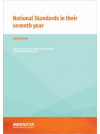This report looks at how National Standards are viewed and used in primary and intermediate schools in 2016, almost seven years since they were introduced.
It draws on data from the NZCER National Survey of Primary and Intermediate Schools, which was conducted in late August and early September 2016.
The survey asked principals and teachers how National Standards data was being used and their views on its impact and value. Some trustees and parents and whānau were also surveyed.
Key Results
The National Standards measures of student performance have now been in place since 2010. The 2016 NZCER national survey of primary and intermediate schools finds that, while they are part and parcel of teaching and school decision making, questions continue around their impact for students, differences in their interpretation and their impact on the rest of the curriculum. Over half of teachers and principals still feel they have not had the support they need to work with National Standards.
• National Standards are seen to shape what schools do by many teachers and some principals. Over two-thirds of teachers reported a narrowing of the curriculum they teach, associated with National Standards; 32% of principals reported that National Standards drives what the school does; and 40% indicated the focus on literacy and mathematics has taken their attention away from other aspects of The New Zealand Curriculum (NZC), which schools started to work with in draft form in 2007.
• But at the same time, more principals said that NZC is driving what they do in their school (54%, up from 38% in 2013), and 43% said that they continue to build approaches and practices that align with NZC.
• Many teachers indicated that their school has a shared understanding of National Standards that means that overall teacher judgements (OTJs) at the school are consistent, and that their moderation work with other teachers has provided insights for their practice. Just over one-third of principals reported their school was working with other schools to moderate National Standards judgements.
• Further external guidance and support for working with National Standards still seemed to be needed. Only 41% of the principals and 49% of teachers thought they had had enough support and guidance to feel confident about their work with National Standards.
• Many principals and teachers had doubts that the National Standards data provide a reliable picture of student performance, whether for their school or for local schools. Respondents’ comments echoed a perception that National Standards represent a narrow slice of what students know and can do, rather than their overall performance.
• National Standards data are used by most principals in school decision making, including identification of students’ learning needs and progress over time, identifying professional learning priorities and resource allocation. Less than half of trustees thought National Standards data were useful for making decisions about resource allocation.
• There is a greater focus on students who are ‘below’ or ‘well below’ National Standards. More teachers than in 2013 were focusing on students who are achieving ‘below’ or ‘well below’ Standards (63% in 2016, up from 47%). While this may seem a positive change in itself, there was also some evidence of less attention for students who already exceed the Standard for their age or year level.

